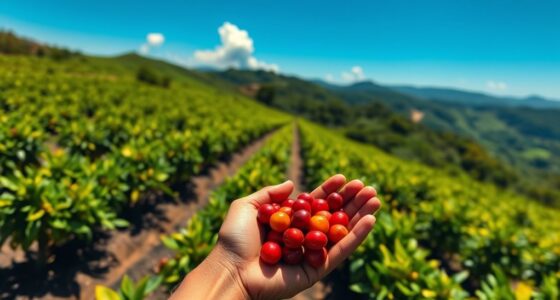Your daily cup of coffee contributes greatly to greenhouse gas emissions, with conventional production releasing over 15 kg of CO₂ per kilo of green coffee. Sustainable practices can cut that footprint to just 3.51 kg. The brewing process also adds to emissions, and using disposable cups makes it worse. By choosing organic beans, non-dairy milk, and brewing only what you need, you can make a positive impact. There’s much more to reflect on about your coffee choices that can help the planet.
Key Takeaways
- Each cup of coffee contributes approximately 0.28 kg of CO₂ emissions, highlighting its environmental impact.
- Sustainable brewing methods can reduce emissions to just 0.06 kg per cup, significantly lowering your carbon footprint.
- Choosing organic coffee beans and non-dairy milk can further decrease greenhouse gas emissions associated with your daily cup.
- Utilizing reusable containers instead of disposable cups can eliminate an additional 16g of CO₂ emissions per cup.
- Mindful brewing practices and energy-efficient machines can reduce overall energy consumption and emissions during coffee preparation.
Understanding the Carbon Footprint of Coffee

When you sip your daily cup of coffee, you mightn’t realize the environmental impact behind it. The carbon footprint of conventional coffee production is significant, releasing about 15.33 kg of CO₂ for every kilogram of green coffee.
In contrast, sustainable practices can cut this down to just 3.51 kg. Each cup you enjoy contributes roughly 0.28 kg of CO₂ emissions, while choosing organic beans or opting for sustainable brewing methods can lower this to 0.06 kg for an espresso.
With 44% of coffee’s carbon footprint stemming from growing and processing, embracing sustainable farming practices is essential. Additionally, brewing methods account for 38% of emissions, highlighting how your choices can contribute to a greener coffee experience.
The Environmental Impact of Coffee Production

When you enjoy your morning coffee, it’s important to reflect on the carbon emissions tied to its production.
With global demand skyrocketing, the pressure on ecosystems intensifies, making sustainable farming practices essential.
Carbon Emissions Overview
The environmental impact of coffee production is significant, as conventional methods release as much carbon dioxide as cheese, making coffee’s carbon footprint substantial.
With over 9.5 billion kg of coffee produced yearly, the industry contributes massively to greenhouse gas emissions. As coffee demand is expected to triple by 2050, the strain on tropical habitats will intensify, worsening the overall environmental impact.
Inefficient energy use and organic waste further exacerbate carbon emissions. However, adopting sustainable coffee practices can reduce these emissions by up to 77%.
It’s essential for the industry to shift towards greener methods of production to mitigate its carbon footprint and protect our planet for future generations.
Sustainable Farming Practices
Conventional coffee farming practices greatly contribute to carbon emissions, but sustainable farming offers a pathway to mitigate these impacts.
By adopting sustainable farming practices, you can help reduce greenhouse gas emissions in coffee production by up to 77% compared to traditional methods. This shift not only benefits the environment but also supports tropical habitats.
Shifting to organic coffee eliminates the need for chemical fertilizers and pesticides, potentially cutting farm-level emissions by one-third.
With over 9.5 billion kg of coffee produced yearly, every choice counts. Remember, the carbon footprint of coffee is already half that of beef, making your coffee choices essential for promoting environmentally sustainable agricultural practices.
Choose wisely and enjoy your cup of coffee with a lighter footprint!
Global Coffee Demand
How does the growing global coffee demand impact our environment?
With annual coffee production exceeding 9.5 billion kg, the environmental impact is significant. The projected tripling of global coffee demand by 2050 will intensify pressure on tropical habitats, pushing ecosystems to the brink.
Coffee produced using the least sustainable methods emits as much CO₂ equivalent as cheese, contributing to greenhouse gas emissions and climate change. Surprisingly, the carbon footprint of coffee is about half that of beef, highlighting the urgent need for sustainable coffee practices.
Sustainable Coffee Practices

When you choose sustainably grown coffee, you’re not just enjoying a great cup; you’re also making a positive impact on the environment.
Greener growing methods and efficient transportation practices can drastically cut carbon emissions, making your coffee habit much more eco-friendly.
Greener Growing Methods
While many coffee lovers may not realize it, the choices made in coffee cultivation can greatly impact the environment. By embracing greener growing methods, you can enjoy your daily cup while supporting sustainable coffee practices. Here’s how:
- Organic cultivation: Avoiding synthetic fertilizers and pesticides can cut carbon emissions by up to one-third.
- Efficient water management: Implementing smart irrigation techniques lowers the environmental impact.
- Renewable energy: Powering farming equipment with renewable sources helps reduce greenhouse gas emissions.
- Ethical standards: Supporting farms that prioritize sustainable methods guarantees a smaller carbon footprint overall.
- Dairy alternatives: Incorporating butter health considerations into your coffee routine can further enhance sustainability by reducing demand for certain dairy products.
Efficient Transportation Practices
Greener growing methods set the stage for a more sustainable coffee industry, but the journey from farm to cup also plays a crucial role in your coffee’s carbon footprint.
Efficient transportation practices, such as using cargo ships instead of air freight, drastically reduce emissions associated with coffee imports. By prioritizing local sourcing, you can further minimize the distance coffee travels, leading to a more sustainable option.
Additionally, optimizing shipping routes and consolidating shipments can markedly decrease the environmental impact of coffee delivery.
With sustainable coffee practices in place, you can contribute to an impressive reduction of up to 77% in overall carbon emissions related to coffee production and consumption, making each cup you enjoy a bit greener.
Coffee Consumption and Carbon Emissions

How much do you think your daily coffee habit contributes to carbon emissions? Your coffee consumption might’ve a bigger impact than you realize.
Here are some key factors affecting your daily cup’s carbon footprint:
- Brewing Process: Almost 38% of CO₂ emissions come from energy use during brewing.
- Brewing Methods: Batch brewing emits about 17g of CO₂, while home espresso machines can raise emissions considerably.
- Sustainable Practices: Using organic beans and avoiding disposable cups can lower emissions from 0.28 kg to as low as 0.06 kg.
- Milk Alternatives: Choosing plant-based milk instead of dairy can further reduce greenhouse gas emissions in your coffee.
The Role of Milk in Coffee’s Carbon Footprint

When you add milk to your coffee, you mightn’t realize just how much it can boost the drink’s carbon footprint.
A latte, for instance, averages about 0.55 kg CO₂, while sustainable practices can lower this to around 0.33 kg.
Cappuccinos clock in at 0.41 kg, but you can shrink that to 0.20 kg with eco-friendly dairy alternatives.
Flat whites typically have a footprint of 0.34 kg, yet sustainable coffee methods can reduce it to as low as 0.13 kg.
The emissions from milk production greatly impact your coffee’s overall footprint, so it’s essential to take into account both your coffee and milk sources.
Brewing Methods and Their Emissions

Have you ever considered how your brewing method impacts your coffee’s carbon footprint?
Different brewing methods come with varying energy consumption and CO2 emissions, affecting sustainability. Here’s a quick look at their environmental impact:
- Batch Brew: Uses 1450 watts for 3 minutes, producing 17g of coffee.
- Plunger Coffee: Requires 1700 watts for 1.5 minutes, resulting in a higher carbon footprint.
- Home Espresso Machine: Consumes 1850 watts for a 5-minute warm-up plus 30 seconds of brewing for 21g of coffee.
- Waste Reduction: Brewing only what you need minimizes energy usage and lowers your overall carbon footprint.
Choosing your coffee maker and method wisely can greatly enhance your coffee preparation while supporting sustainability.
Strategies for Reducing Your Coffee’s Carbon Footprint

While every cup of coffee brings joy, it’s essential to contemplate ways to minimize its environmental impact.
Start by brewing only what you need to avoid waste and save energy; excessive brewing increases emissions. Hydration support from coffee can also be achieved by consuming it mindfully.
Opt for organic coffee beans, which can cut emissions by up to one-third by avoiding synthetic fertilizers.
Consider using non-dairy milk alternatives to further lower your coffee’s carbon footprint, as dairy contributes significant emissions.
Ditch disposable coffee cups, which add 16g of CO₂ per cup, and switch to reusable containers to reduce waste.
Finally, turn off your coffee maker instead of leaving the warming plate on, and use a thermos to keep your coffee warm, saving energy and reducing emissions.
Incorporating essential oils for relaxation into your coffee routine, such as a drop of peppermint, can enhance your experience while promoting a calming effect on the environment.
The Importance of Sustainable Choices in Coffee Consumption

Making sustainable choices in your coffee consumption not only enhances your enjoyment but also plays an essential role in reducing environmental impact.
By selecting sustainable options, you can considerably lower the carbon footprint of your daily cup. Here are some simple steps to reflect on:
- Choose sustainable coffee: Opt for brands that prioritize eco-friendly practices.
- Use organic coffee beans: They can reduce farm-level emissions by up to one-third.
- Try non-dairy milk alternatives: These can help minimize additional carbon emissions.
- Avoid disposable cups: Each one contributes an extra 16g of CO₂.
Frequently Asked Questions
What Is the Carbon Footprint of a Cup of Coffee?
When you brew a cup of coffee, you’re contributing to its carbon footprint, which typically measures around 0.28 kg of CO₂ for a conventional serving.
Most emissions come from farming, processing, and consumption.
If you choose sustainable practices, like organic cultivation, you can notably lower this footprint.
What Is Your Carbon Footprint in Your Daily Life?
Your carbon footprint in daily life dances like shadows on a sunlit path, subtly revealing the impact of your choices.
Every step you take, every meal you savor, adds to your environmental mark. You might drive a car, rely on electricity, or indulge in quick meals, all contributing to your footprint.
What Is the Carbon Footprint of a Plastic Cup?
The carbon footprint of a plastic cup is about 16 grams of CO₂, stemming from its production and disposal.
If you use it for a hot drink, the energy needed for heating can boost its impact.
Plus, the production of these cups contributes to the broader issue of plastic waste, which harms the environment.
What Food Has the Worst Carbon Footprint?
What food do you think has the worst carbon footprint? If you guessed beef, you’re right! It generates around 7.7 kg of CO₂ for just a 1,500g serving, making it the top culprit among common foods.
While pork and farmed fish are less impactful, they still contribute to emissions.
Conclusion
As you savor that warm cup of coffee, imagine each sip as a tiny ship sailing across an ocean of choices. With every decision—be it the beans you choose, the milk you pour, or the brewing method you embrace—you wield a compass guiding this vessel toward sustainability. By steering your coffee habits with care, you’re not just enjoying a drink; you’re charting a course for a greener planet, transforming every cup into a beacon of hope.









